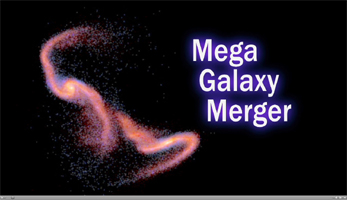Mega Galaxy Merger

Click on the image for the animation
This simulation shows the merging of two massive galaxies, sped up to cover 1.5 billion years of time. The merging galaxies are split into two views: a visible-light view is on the left, in which blue shows young stars and red indicates older stars and dust. The view at right shows emission from dust, which is what infrared telescopes like the Herschel Space Observatory see. When the galaxies finally merge, the strong burst of star formation can be seen best in infrared views.
Herschel and a band of other telescopes teamed up to discover a massive galaxy collision that took place when the universe was 3 billion years old. The discovery helps explain how giant galaxies form.
NASA's Herschel Project Office is based at the agency's Jet Propulsion Laboratory in Pasadena, Calif., which contributed mission-enabling technology for two of Herschel's three science instruments. JPL is a division of the California Institute of Technology, Pasadena.
More information is online at http://www.herschel.caltech.edu,http://www.nasa.gov/herschel and http://www.esa.int/SPECIALS/Herschel.
